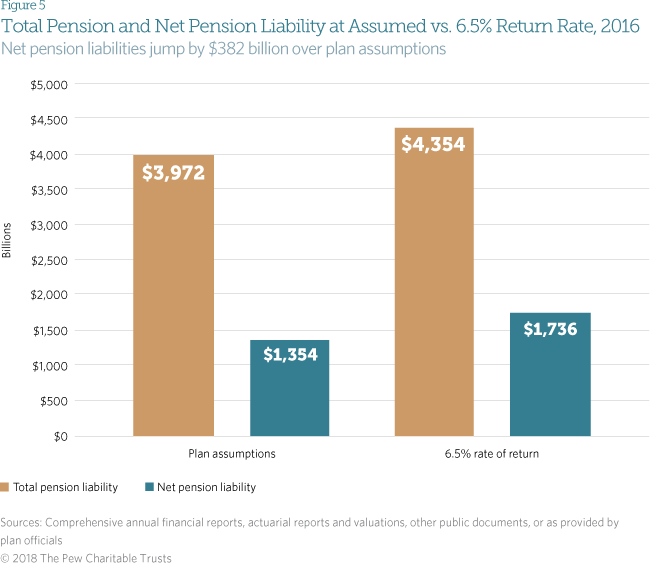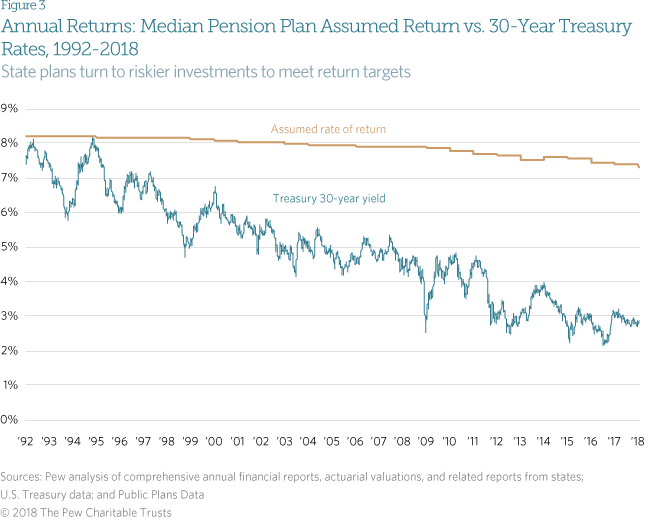At a time when teacher protests around the country seek higher wages and benefits, a new study illustrates the depth of the problem. The funding deficit for US state public pension systems rose $295 billion in 2016, leaving in its wake a record $1.4 trillion gaps.
Moody’s: Local US Governments Stable, but Pension Burden Swelling
The underfunded pensions vary state by state but are due to lower investment returns, and insufficient state funding comes amid taxpayers increasingly footing the bill.
Calling the situation “unsustainable,” the Pew survey released Thursday that pension funds had only $2.6 billion in assets to cover nearly $4 trillion in liabilities. This is the 15th annual increase in pension debt since 2000. The moves come as contributions from taxpayers doubled over the past decade as a share of state payments.
Bernstein: It Is “Incredibly Unlikely” That Pension Funds Can Produce 7% Annual Returns On Domestic Assets






State pension plans face a growing number of challenges, from disappointing investment returns to aging demographics drawing benefits in record numbers. The median public pension plan’s investments returned only about 1% in 2016, significantly under the median assumption of 7.5% The S&P 500 returned 11.96% that year. This investment miss added nearly $146 billion to the debt.
Even if plan assumptions had been met, the funding gap would have increased by $13 billion due to states not allocating enough to their pensions. The states needed to contribute $109 billion, but only put in $96 billion.
Pension Assets Up, But So, Too, Are Liabilities
Pension liabilities played a role in increasing net pension liability because contribution policies did not raise sufficient revenue to meet the growing costs. Pew points out states needed to contribute $109 billion, but in fact, actual employer contributions fell short by nearly $13 billion. Recent changes to accounting rules also played a role in the fluctuating net pension liability. New GASB standards report pension assets using actual market values rather than the traditional calculations that smoothed gains and losses over time, which results in reporting volatility in annual funding levels.
“There is no one-size-fits-all solution to the pension funding shortfall and the budgetary challenges facing individual states, but without new policies that commit states to fully funding retirement systems, the impact on other essential services—and the potential for unpaid pension promises—will increase,” the report said. “Ultimately, differences in state pension funding levels are driven by policy choices, with well-funded states having records of making actuarial contributions, managing risk, and avoiding unfunded benefit increases.”
Pension Crisis Is Much Worse Than It Seems
Primary states with funding ratios below 60% included New Jersey, Illinois, Massachusetts and Pennsylvania. There were only four states with funding over 90%, including New York, Wisconsin, Tennessee and South Dakota.
“Ultimately, differences in state pension funding levels are driven by policy choices, with well-funded states having records of making actuarial contributions, managing risk, and avoiding unfunded benefit increases,” the report said. “Many state retirement systems are on an unsustainable course, coming up short on their investment targets and having failed to set aside enough money to fund the pension promises made to public employees.”
There is potentially good news on the horizon. Early reports indicate strong 2017 stock and real estate market performance could reduce reported unfunded liabilities. “However, that same market volatility could have an adverse impact in the long term, especially if lawmakers also fail to make adequate annual contributions to state plans,” the report warned, pointing out that even small changes to projected returns can significantly increase liabilities. Pew, for instance, applied a 6.5% return assumption, instead of the median assumption of 7.5% and found that it would grow liability to $4.4 trillion, or $382 billion more than the current amount. The funding gap would likewise balloon to $1.7 trillion.
Via Pew


